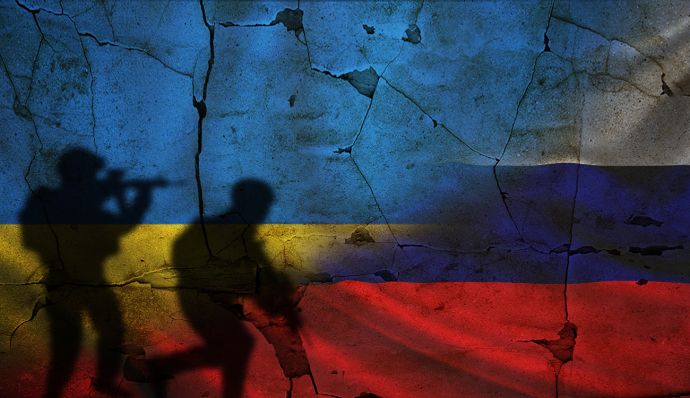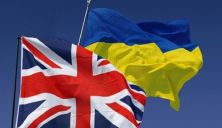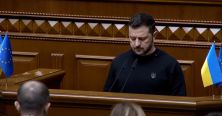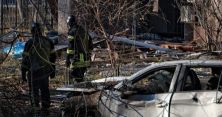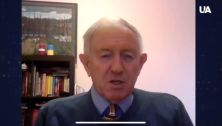Today marks 1,000 days since Russia initiated its full-scale invasion of Ukraine on February 24, 2022—a grim milestone that reflects both the enduring hardship and remarkable resilience of the Ukrainian people. This war has become one of the most significant and devastating conflicts in Europe since World War II, with far-reaching implications for global security, international law, and humanitarian efforts.
A Nation Under Siege
In these 1,000 days, Ukraine has withstood relentless attacks, including missile strikes on civilian infrastructure, mass displacement of its population, and atrocities that have drawn widespread condemnation as potential war crimes. The invasion has claimed tens of thousands of lives and displaced millions, turning bustling cities into battlegrounds and reducing entire communities to rubble. Despite these challenges, the Ukrainian spirit of resistance has become a symbol of defiance and hope for nations around the world facing authoritarian aggression.
Global Response
The invasion has not only reshaped Ukraine but also transformed global alliances and policies. Western nations have rallied unprecedented military and economic support for Ukraine, including advanced weapons systems, financial aid, and humanitarian assistance. Institutions like NATO have strengthened their posture, with Finland joining the alliance and Sweden on the path to membership, directly countering Russia’s goal of weakening Western unity.
Conversely, the war has exposed divisions among nations, with some choosing neutrality or closer ties to Moscow, complicating global efforts to isolate Russia. Sanctions have hit the Russian economy, but their effectiveness remains a matter of debate as Moscow continues to fund its war machine.
Human and Economic Costs
The toll of the war is staggering. According to estimates, millions of Ukrainians remain displaced internally and abroad. Key sectors of Ukraine’s economy have been devastated, with infrastructure losses exceeding hundreds of billions of dollars. Yet, the economy has shown remarkable adaptability, with some recovery in 2024 driven by industries like construction and transport, alongside international aid efforts.
The war has also highlighted the profound environmental damage caused by large-scale military operations, including polluted lands, damaged ecosystems, and risks from attacks near nuclear facilities.
The Road Ahead
As Ukraine and its allies mark this milestone, the future remains uncertain. Ukraine’s counteroffensive has reclaimed significant territories but at a high cost, and Russian forces continue to launch devastating strikes. Diplomacy remains elusive, with Ukraine insisting on a peace that restores its territorial integrity, while Russia shows no signs of retreating from its imperial ambitions.
For Ukraine, these 1,000 days are a testament to its resolve to remain independent, free, and sovereign. For the world, it is a stark reminder of the cost of inaction against aggression and the enduring importance of standing with those who fight for their right to self-determination.
The resilience of the Ukrainian people and the solidarity of its allies underscore the hope that, in the end, justice and peace will prevail.
Chronicle
The morning of February 24, 2022, began for peaceful Ukrainian cities with massive rocket and artillery shelling – Russia began a full-scale invasion of Ukraine. Since then, the sounds of air raid sirens have become an integral part of the lives of Ukrainians.
At the beginning of the invasion, Russian troops entered the territory of Ukraine from Belarus. They moved to Kyiv through the Chernihiv and Sumy regions. The Russian army also began a large-scale offensive from the temporarily occupied territories of Donetsk, Luhansk regions and Crimea. The soldiers were traveling with sets of dress uniforms. Putin expected that the capital of Ukraine would fall in a few days, and the occupation forces would hold a parade on Khreshchatyk.
The Russian dictator appealed to the Ukrainian military with a call to lay down their arms. However, the Ukrainians did not surrender. On the contrary, after the first Russian air strikes, queues formed outside the territorial recruitment centers (TRC). Hundreds of thousands of citizens took up arms to defend their homes from the occupiers.
“The whole nation is standing in our defense. The whole world supports us, everyone supports us. The truth is that everyone is on our side,” said volunteer Vitaliy.
“We are all here, our military is here, citizens, society is here, all of us are here, defending our independence, our country. It will be like this in the future. Glory to our defenders! Glory to our defenders! Glory to Ukraine!” President Volodymyr Zelensky addressed the Ukrainians.
The Ukrainians responded to the full-scale invasion of Russia with a powerful volunteer movement. People provided support to internally displaced persons, supplied the army with what they needed, helped doctors and rescuers. In three months of a full-scale war, the volunteer platform, launched with the support of UNICEF, united more than 400 thousand participants and over 500 organizations in Ukraine. Tens of thousands of people in Europe, the USA, Canada and other countries joined the Ukrainian volunteers. People took to the streets to demonstrate their support for Ukraine and condemn Russian aggression. Numerous protests took place in Berlin, Paris, London, New York, Warsaw and other capitals.
“We need funds, we need weapons, ammunition, ready-made food and much more, we need this help now. Please, be on Ukraine’s side!” urged protester Natalia Galych.
In April 2022, the Ukrainian army drove the Russian occupiers out of the Kyiv, Chernihiv and Sumy regions. Then Kyiv’s allies decided: it was time for more significant military assistance. US President Joe Biden asked Congress to allocate $33 billion to help Ukraine.
“To support Ukraine in its continued struggle, I am sending Congress a request for an additional budget that will allow for an uninterrupted supply of weapons and ammunition to brave Ukrainian fighters and continue to provide economic and humanitarian assistance to the Ukrainian people. This additional funding addresses the needs of the Ukrainian military during the critical weeks and months ahead, and it begins the transition to longer-term models that will help Ukraine deter and continue to defend against Russian aggression,” said US President Joe Biden.
By the fall of 2022, American “Hymars”, British howitzers, Polish artillery systems, and German air defense systems entered service with the Ukrainian army. Kyiv decided to launch a counteroffensive in the Kharkiv and Kherson regions.
The Russian occupiers abandoned their positions, leaving behind ammunition and military equipment. In the Kharkiv region, the Ukrainian Armed Forces liberated about 8 thousand square kilometers of territory and more than 300 settlements. In the south, the Ukrainian Defense Forces broke through to Kherson, occupied by the Russian army.
The main targets of the Ukrainian military were the supply routes of the Russian army, ammunition depots, and command posts. The losses of the army of the aggressor country were so large that the Russian army was forced to leave Kherson and retreat to the left bank of the Dnieper. On November 11, 2022, the Ukrainian Armed Forces entered the city.
As in other territories liberated from the Russian occupiers, torture chambers were discovered in Kherson. At least 450 Ukrainians passed through one of them, in a temporary detention facility, the Kherson region police reported.
“For the first time, we found a separate cell for teenagers, I would say, for children. According to witnesses, they saw boys who were kept there. Some looked like they were under 14. We had never recorded anything like this before. Here, Russia has already gone so far as to make a separate cell for children, where they were beaten in exactly the same way,” said Dmitry Lubinets, the Ukrainian Parliament Commissioner for Human Rights.
The whole world learned about the mass atrocities of the Russian army in the occupied territories of Ukraine. In Bucha, Gostomel and other cities of the Kyiv region, an international investigative team documented cases of mass executions, torture and cruel treatment of local residents.
In 2024, the Parliamentary Assembly of the Organization for Security and Cooperation in Europe (OSCE) recognized Russia’s actions as genocide against the people of Ukraine. The International Criminal Court in The Hague continues its independent investigation into the crimes of the aggressor country.
“The Commission has concluded that the Russian authorities have committed numerous violations of international humanitarian law and international law in addition to a wide range of war crimes, including war crimes of causing incidental injury or damage, wilful killing, torture, abuse of persons, rape, as well as unlawful transfer and deportation,” said Erik Møse, Chairman of the Independent International Commission of Inquiry on Violations in Ukraine.
Russia systematically and deliberately violates the Geneva Conventions and the rules for the treatment of prisoners of war, said Dmitry Lubinets, the Ukrainian Parliament Commissioner for Human Rights. There are numerous known cases of executions of captured Ukrainian soldiers. All Ukrainian Armed Forces servicemen who have returned from Russian captivity tell of violence and torture.
In an attempt to advance on the front and stop the Ukrainian Armed Forces counteroffensive, the Russian army is using scorched earth tactics. On June 6, 2023, Russian occupiers blew up the Kakhovka hydroelectric power station dam. Ecocide is how international law classifies this crime by the aggressor country. Mariupol, Bakhmut, Volnovakha, Avdiivka and hundreds of other Ukrainian cities and villages were destroyed by the Russian army. Hundreds of thousands of Ukrainians fled their homes.
“And I was born in the war, it was a month before the war of 1941, exactly a month. And now I’m 83 years old, and again I have to drop everything and go. There, in the Volyn region, it’s very nice and the people are very kind. But I still want to go home, I want to lie down on my pillow, cover myself with my blanket,” says Lidiya, a resident of Mirnohrad, Donetsk region.
Since the beginning of the full-scale invasion of the Russian army into Ukraine, the occupation authorities have been forcibly removing Ukrainians from the occupied territories to the Russian Federation. We are talking about tens of thousands of people. Moscow has illegally deported more than 20,000 Ukrainian children and is doing everything to make it difficult for them to return. Even adult Ukrainians have a hard time getting out of Russia.
“We spent a long time going through the filtering in Starobeshevo. Then we couldn’t buy tickets: they weren’t selling them to Ukrainians. Then they started selling tickets — they kicked us off the train. It was a miracle we managed to leave. And I was on the road for almost a month, in refugee camps. And I had to [go] through Warsaw to escape from the Russian Federation,” said Natalia, a resident of Mariupol in Donetsk region.
The International Criminal Court has issued an arrest warrant for Putin for the illegal and forced deportation of Ukrainian children. The Russian dictator has become a no-no. Russia has had to form alliances with the same outcasts. Tehran and Pyongyang have been supplying Moscow with weapons since the start of Russia’s full-scale invasion of Ukraine. Due to record losses in the Russian army, the Kremlin has once again violated UN Security Council resolutions and brought troops from North Korea (DPRK, Democratic People’s Republic of Korea) into the war against Ukraine.
“By supplying ammunition and ballistic missiles, North Korea has sent troops to fight and die alongside Russia in its illegal war. In return, Russia is providing North Korea with funding and missile technology. This is very worrying. These missiles pose a direct threat to the mainland United States, to Europe, to the Indo-Pacific region. And to the entire Euro-Atlantic area,” said NATO Secretary General Mark Rutte.
Russia, like Iran and North Korea, has become one of the most sanctioned countries in the world. The European Union alone has already adopted 14 packages of restrictions against the aggressor country.
“We need to strengthen measures to counteract the circumvention of sanctions. Because Russia cannot produce anything without foreign parts, chips, components. We need to use sanctions to isolate Russia’s industrial potential. So that they do not have the opportunity to import the necessary components from other countries,” stressed EU High Representative for Foreign Affairs and Security Policy Josep Borrell.
Over the 1,000 days of Russia’s war against Ukraine, the entire world has become convinced of the illusory nature of Putin’s notorious “red lines.” The desperate dictator’s last argument — nuclear blackmail — no longer stops Kyiv’s allies. And the Ukrainian Defense Forces have entered the Kursk region and are successfully repelling the Russian army’s attempts to oust the Ukrainian military from their positions. From supplying military helmets, the partners have moved on to supplying fighters — first the F-16, and now the Mirage 2000-5F.
“We are going to start a new cooperation and announce the supply of Mirage 2000-5 aircraft, which will allow Ukraine to protect its skies. We will train Ukrainian pilots. This usually takes 5-6 months. Ukrainian pilots will be trained in France,” said French President Emmanuel Macron.
The Ukrainian army has become one of the strongest in Europe. In addition to introducing Western weapons, Ukraine has launched its own production of armored vehicles, self-propelled artillery units, and innovative drones. In order to attract additional investments, Kyiv has already held two International Defense Industry Forums. They were attended by representatives of dozens of countries and hundreds of companies.
“If once, years ago, the Ukrainian defense industry looked, unfortunately, helpless, now it is an industry that is on the way to leadership at least in Europe. Now these are industries that Ukraine can again be rightfully proud of. Thanks to the defense industries, Ukraine should become one of the key global donors of security and a very strong player in the global market of weapons and defense technologies. Everyone who is with us, who is with Ukraine, I am sure, will win,” said Ukrainian President Volodymyr Zelenskyy.
Ukraine strives for a fair end to the war. The main principles are set out in the peace formula presented by the Ukrainian president. To discuss it, Kyiv convened the Global Peace Summit. In June 2024, leaders and heads of government of 93 countries and representatives of international organizations arrived in Switzerland. In the final communiqué, the participants called for the release of all prisoners of war, support for global food security, and the transfer of the Zaporizhzhya Nuclear Power Plant (ZNPP) to Ukrainian control.
Kyiv is preparing for the Second Peace Summit. A lasting and just peace can only be established on Ukraine’s terms.
Read also: Sybiha, Barrot discuss defense cooperation

